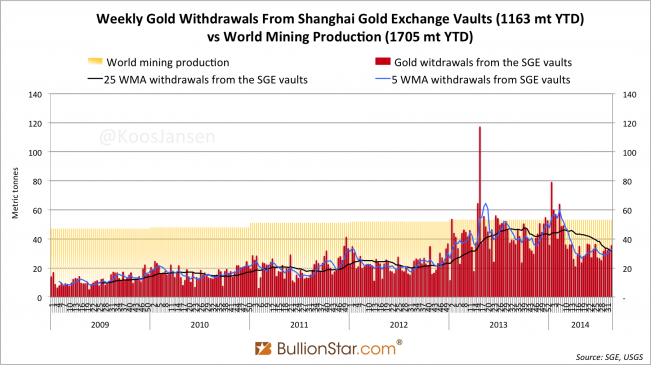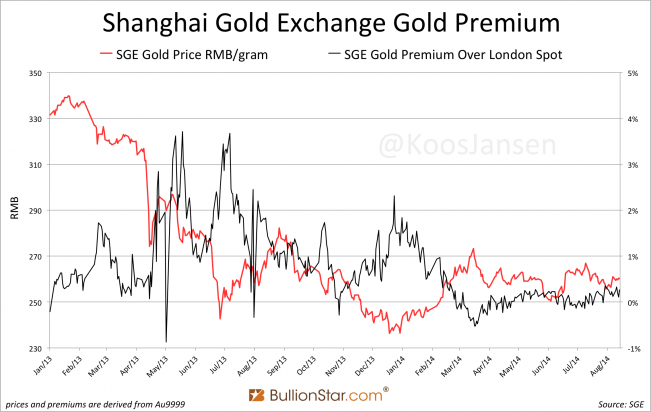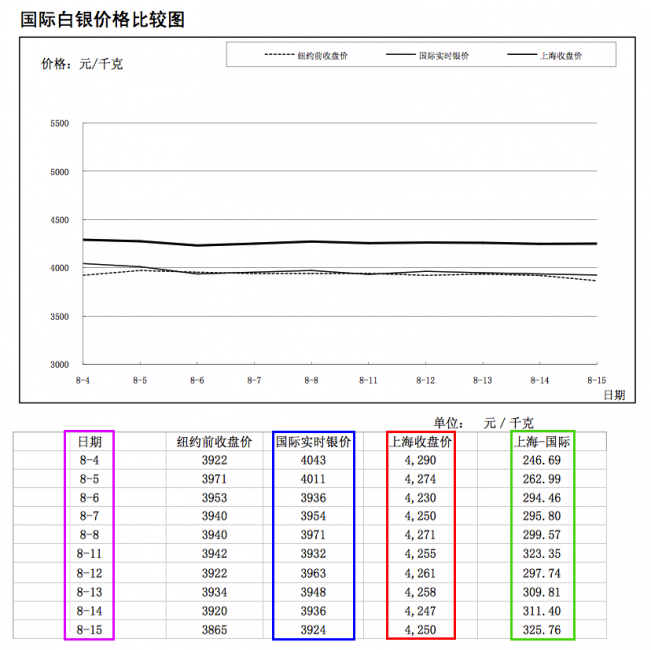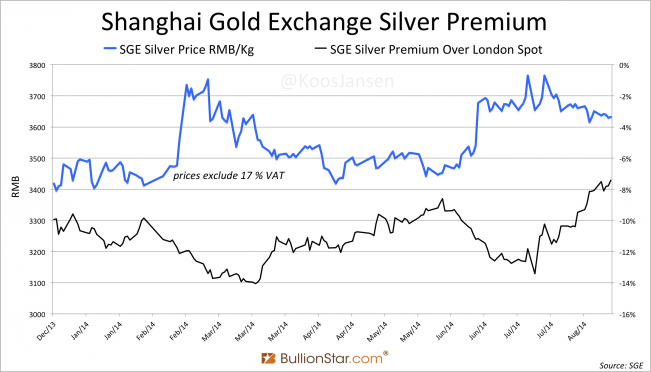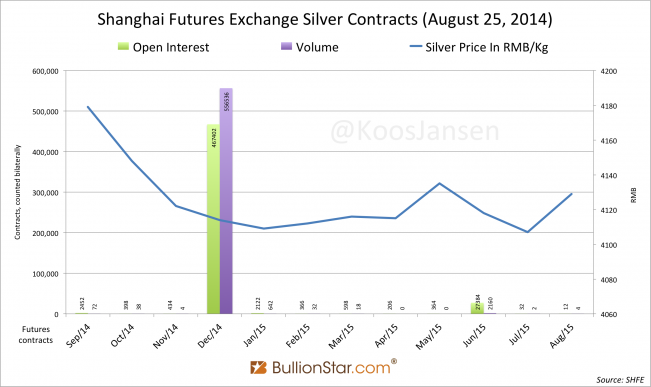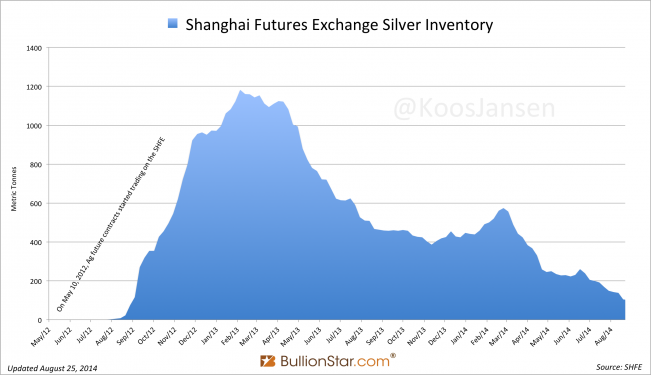Chinese Gold Demand 1163 MT YTD
25 Aug 2014 17:00
Koos Jansen
Withdrawals from the Shanghai Gold Exchange (SGE), which equal Chinese wholesale demand, accounted for 35 metric tonnes in week 33 (August 4 – 8). Up 7.25 % w/w, additionally the largest amount withdrawn in 8 weeks. Year to date 1163 tonnes have been withdrawn, for which I estimate 723 tonnes had to be net imported into the mainland.
Premiums have kept up just above zero.
In previous posts I’ve reported on the silver premium as disclosed by the SGE. In the weekly SGE reports the difference between the closing price of the spot deferred contract Ag(T+D) and the concurrent “international price” in renminbi per Kg is displayed. The next screen shot was taken from the most recent report. The bold header says “International silver price comparison chart”.
- The purple column is the date
- The blue column is the international price at the SGE close (3:30 pm GMT+8)
- The red column is the price of Ag(T+D) at the SGE close
- The green column is the difference between the international and the SGE price
As some of you may have noticed a few weeks ago I reported silver contracts on the SGE are quoted including 17 % VAT. In contrast to what the SGE international silver price comparison table suggests, a price premium of 7 % in reality is a discount of approximately 10 %, taken into account SGE prices include 17 % VAT.
In all honesty, when I found out silver on all Chinese commodity exchanges is quoted including 17 % VAT, I couldn’t comprehend it. There must be a logical explanation for this, I thought. Why would the SGE disclose discounts as premiums? Hard to grasp, but they do.
From The Chinese Silver Market, published by the Silver Institute:
It is worth stressing here that silver prices quoted on commodity exchanges in China have already included a 17 % VAT.
…As mentioned earlier in this report, since the liberalization of the Chinese silver market, all silver transactions are subject to 17 % VAT in China. In other words, local smelters need to pay 17 % tax on silver contained in imported concentrates (typically based on international prices). However, as domestic prices (excluding tax) have been trading consistently lower than the international price, it is not surprising that local smelters tend to prefer low silver content in imported concentrates.
From the Shanghai Futures Exchange (SHFE) rulebook:
Article 44. The contract price of a futures contract means the price including the value added tax, or the VAT, for the contract’s underlying standard grade of commodity delivered at the benchmark delivery warehouse.
Further research has pointed out silver prices on all Chinese commodity exchanges indeed include 17 % VAT and the pure price of silver in China is not higher relative to London spot, but lower. The next chart is the SGE silver premium based on prices excluding VAT.
Many questions can be raised at this point. Why are silver prices quoted including VAT on Chinese commodity exchanges? Why isn’t the price difference being arbitraged? Why is China importing silver when domestic prices are lower? Is it coincidence silver trades in backwardation on the SHFE when “premiums” are high? Why hasn’t any analyst ever written about this (or did I miss it)?
These questions can all be answered, however, it will take me more time to research the VAT structure in Chinese trade and in what forms (ore, slime, paste, powder, bullion) silver is distributed to answer all of them. My aim is to write an in-depth analysis of the Chinese silver market to get a comprehensive understanding of this matter.
Meanwhile, in the local silver market of Shanghai, which is shielded from international markets because of a required VAT on export, poor man’s gold is trading in backwardation since August 5.
On August 25, 2 tonnes left the SHFE vaults, which brings the total stock to 103 tonnes.
While all this information on the Chinese silver market might seem confusing and discordant, it will all make sense eventually.
Popular Blog Posts by Koos Jansen
 China’s Secret Gold Supplier is Singapore
China’s Secret Gold Supplier is Singapore
 Audits of U.S. Monetary Gold Severely Lack Credibility
Audits of U.S. Monetary Gold Severely Lack Credibility
 China Gold Import Jan-Sep 797t. Who’s Supplying?
China Gold Import Jan-Sep 797t. Who’s Supplying?
 The Gold-Backed-Oil-Yuan Futures Contract Myth
The Gold-Backed-Oil-Yuan Futures Contract Myth
 Estimated Chinese Gold Reserves Surpass 20,000t
Estimated Chinese Gold Reserves Surpass 20,000t
 Did the Dutch Central Bank Lie About Its Gold Bar List?
Did the Dutch Central Bank Lie About Its Gold Bar List?
 PBOC Gold Purchases: Separating Facts from Speculation
PBOC Gold Purchases: Separating Facts from Speculation
 U.S. Mint Releases New Fort Knox Audit Documentation
U.S. Mint Releases New Fort Knox Audit Documentation
 China Net Imported 1,300t of Gold in 2016
China Net Imported 1,300t of Gold in 2016
 Why SGE Withdrawals Equal Chinese Gold Demand and Why Not
Why SGE Withdrawals Equal Chinese Gold Demand and Why Not





